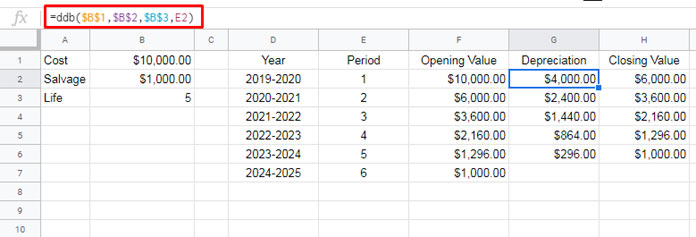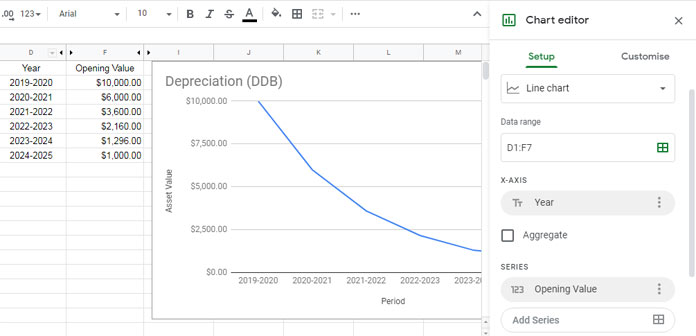Google Sheets DDB function is categorized under the financial functions and one of the functions for calculating the accelerated depreciation of an asset.
In the accelerated depreciation calculation, the depreciation amount will be higher in the initial years. So companies prefer this method as it will be helpful to minimize taxable income to some extent.
As you may know, the function SYD is also for calculating accelerated depreciation. I have already elaborated on the use of the SYD function in an earlier tutorial HERE. It follows the sum of the years’ digit method to allocate depreciation of an asset in its useful span of life.
A separate tutorial for comparing financial functions for accelerated depreciation is in the pipeline. Once ready, I will link that here. In this tutorial let me explain how to use the DDB function in Google Sheets.
Syntax of Google Sheets DDB Function
DDB(cost, salvage, life, period, [factor])It follows the same pattern of other depreciation functions. So it’s easy to understand the DDB function arguments. The first three arguments are common in all the depreciation functions.
cost – It’s the cost (initial cost) of the asset that you want to depreciate.
salvage – The residual value of the asset. It’s the expected value at the end of the depreciation.
life – The useful life span (period) of the asset that means the number of periods the asset is depreciated.
factor – The factor by which depreciation decreases. It’s optional and default by 2 (means double declining).
If you check the SYD function (another accelerated depreciation function) you can understand that the argument “factor” is not a part of it.
How to Use the DDB Function in Google Sheets
Formula example to Google Sheets DDB Function:
| A | B | |
| 1 | Cost | $10,000.00 |
| 2 | Salvage (Residual/Scrap Value) | $1,000.00 |
| 3 | Life (Useful Life) | 5 |
| 4 | Period | 1 |
Formula:
=DDB(B1,B2,B3,B4)As per the above example, the depreciation amount for the 1st period using the Double Declining Balance (DDB) method will be $4,000.00
The useful life of the above asset is 5 years and we have calculated the depreciation amount for the first period (year).
See the below table which uses Google Sheets DDB function to find the depreciation of the said asset in its useful period of life (5 years).

The DDB formula in cell G2 takes the input values from the cells B1 (cost), B2 (salvage), B3 (life) and the period from the cell E2.
When I drag the formula down the formula takes the period (years) from cell E3, E4 and so on because I have used the relative cell reference. Except for cell E2, other cell references are absolute (see the dollar sign) in the formula.
Understand the Double Declining Balance Calculation
To understand the double declining balance calculation you must first know the depreciation calculation using the Straight Line depreciation (SLN) method.
In my SLN tutorial, I have given the SLN manual calculation formula. It’s like;
SLN = (cost – salvage)/lifeIf you use the input values in the DDB formula here, the SLN calculation would be like;
=(10000-1000)/5Result: $1,800.00
The same can be calculated using the built-in function as below.
=sln(10000,1000,5)Result: $1,800.00
The above output $1,800.00 is equal to 20% of the asset value-salvage value (9000/1800).
That means using the Straight Line depreciation method, the depreciation amount will be 20% each year ( $1,800.00 * 5 years). I am going to relate this with the DDB. How?
In the Double Declining Balance method, the percentage will be double that means 40% in each year. Unlike the SLN, here, the depreciation amount won’t be fixed each year.
For the second year and the remaining years, the percentage will, of course, be 40% but will be calculated by multiplying the remaining book value of the asset.
That means in the 1st year the depreciation is $10,000.00*40% = $4,000.00. In the 2nd year, the depreciation value will be $6,000.00*40% = $2,400.00, and so on.
Hope you could understand the use of Google Sheets DDB function and the Double Declining Balance method.
For your information, the VDB function also uses the double declining balance method. This function is more flexible than DDB as it lets you input start and end date to calculate the depreciation.
DDB Depreciation Chart in Google Sheets
We can quickly plot a DDB line chart use the table provided above. In that table, just hide the columns E, G, and H. Then select D1:F7 and hit the shortcut Alt+I+H (you can also insert a chart from the Insert menu).
In the chart editor panel, do change the chart type to Line and there you are!

That’s all about the DDB function in Google Sheets. Enjoy!





















